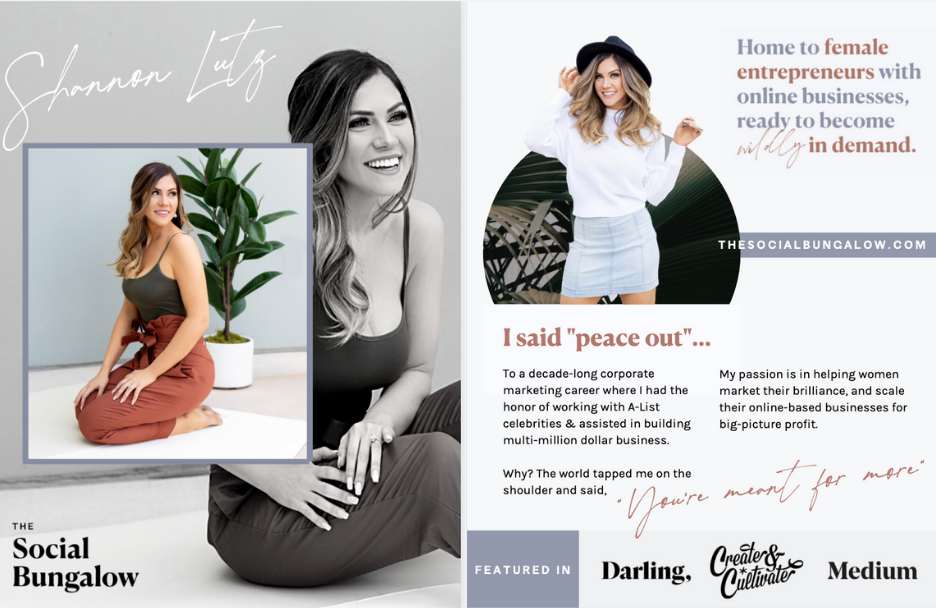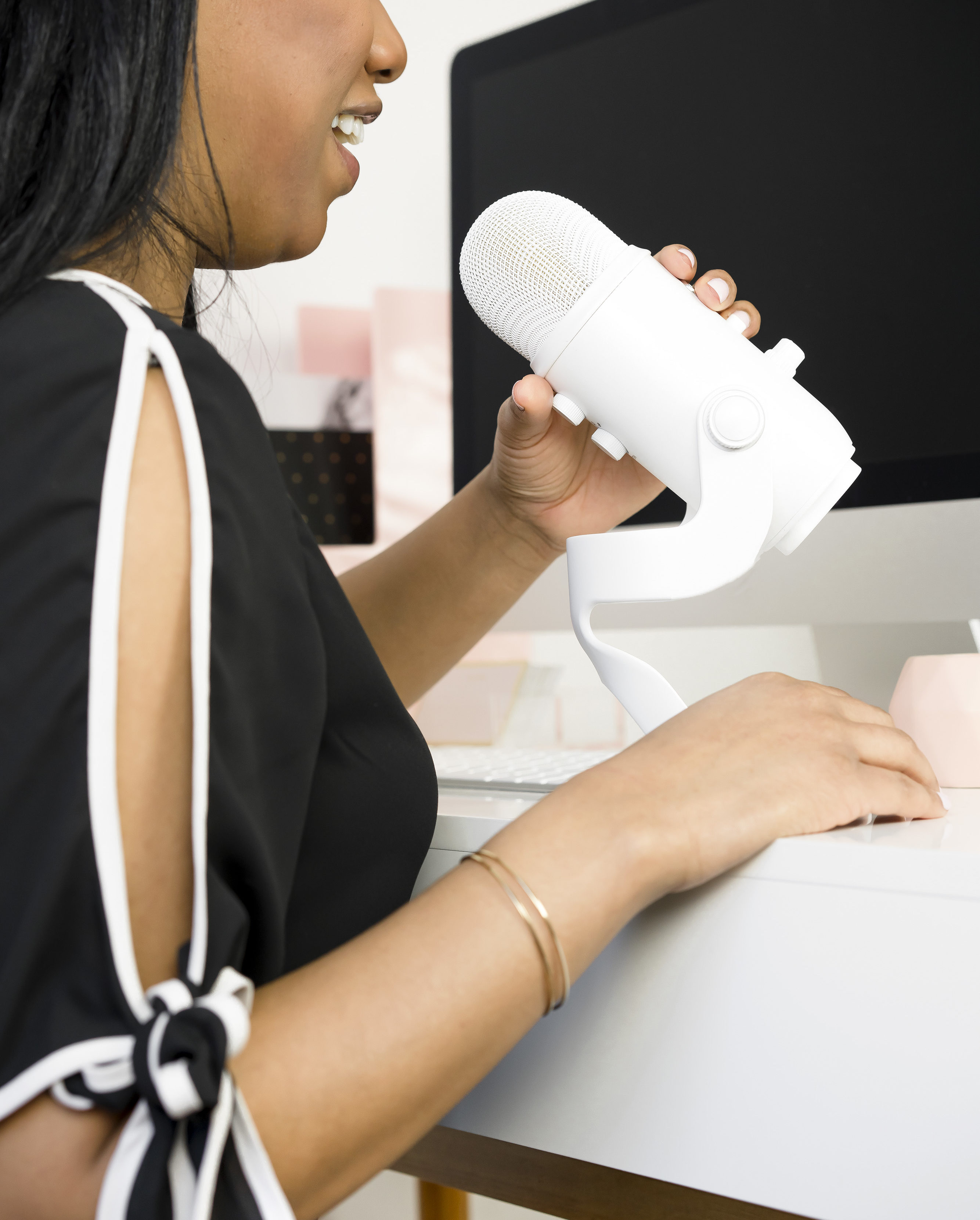By Shannon Lutz
When Annalyse, Bungalow Executive Assistant, shared a sneak peek of my media kit on IG Stories, so many peeps ran to the DM’s to ask more. I heard your questions loud and clear, so let’s explore more of the awesome tool that has helped us land some of the biggest opportunities.
What is a Media Kit
A media kit is a powerful tool for sharing your brand with potential collaboration partners, journalists, and organizations you’re pitching to. Typically, between 2-5 pages, a stellar media kit hits a few key points that highlight the best of your business. This beautifully packaged breakdown can be emailed out at a moment’s notice, saving you time on the typical back and forth. Ultimately your media kit needs to talk enough to excite a journalist or event coordinator, without creating information overwhelm and indecision. Consider this your virtual elevator pitch, with the twist of gorgeous visuals and concrete data.
Who Needs a Media Kit
You do. Whether you’re an established business with opportunities flowing or just getting your feet wet in the world of promotions, a media kit is essential. Entrepreneurs, public speakers, influencers, and everyone in between should have a media kit that they update regularly to secure higher-level collaboration opportunities.

What Goes in a Media Kit
Media Kits can be DIYed in Canva, made with templates from Creative Market, and outsourced to skilled graphic designers. I worked with Alex of High Moon Studios to design my brand/elements, and then took those pieces into Canva to DIY this myself. Before you jump into the design process, gather the relevant data, photos, and any other information you want need to include. While this is totally custom to you and your business, most media kits should include a few basic things:
Introduction
Who are you? What does your business do? How can you quickly convey your unique story?
Audience Breakdown
What does your community look like? Describe the demographics and type of person from your audience who actively consumes your content.
Social Media Analytics
Where do you live on social? What are your follower count, engagement rate, and swipe up numbers on IG Stories, etc?
Website & Email
What does your online presence look like? Who reads your email campaigns? Who’s stopping by your site?
Mention of Previous Features
What have you done in the past that would interest future partners? Any news features or exciting sponsorships?
Contact Information
What is the best way to get in touch?
Brand Images
What do you look like? What photos represent your business and personality the best?
Additionally, you can include your rates for collabs and speaking engagement and special projects that might not be apparent to the general public. While this might sound like an overwhelming amount of information, it all comes together beautifully.
Now that you have all of the leg work and data gathering complete, you can plug and play with media kit templates or simply do a handoff to your designer. The finer details will come as you work through the assembly process. You’ll find that not all of the data is relevant, so think back on the common questions you get from potential partners to determine the big pieces to hit. If you’re just starting out you may be focused more on the qualitative substance, or your specific niche might lend itself to a different style of media kit than what you see from me.
Remember, this is yours and yours alone. The information you share in your media kit is meant to propel you forward toward new opportunities, so really own that which will make you stand out in the crowd. As long as you’re not forgoing important data, you can’t be too creative or too unique.
The Finer Details
It really is all in the details when it comes to your media kit. With my own media kit, it’s important that it is easy to read, has quality images, feels cohesive in theme, and makes bold statements. I utilize multiple images on each page, so I have only the most important photo in color and make the rest black and white. This makes it easy for readers to scan without getting distracted or visually overwhelmed. When I’m sharing multiple data points, I’ll round down to the nearest whole or half number so that readers can quickly process all of the information on the page.
While these details will vary depending on your industry and goals, make sure that you keep the reader’s experience in mind. They probably don’t have much time to spend reading through your whole media kit, so do everything that you can to make a big statement without weighing them down in all the extra fluff. Frame it this way – let’s say you’re bringing someone in to speak to your precious audience, if you have 60 seconds to sneak a peek at their media kit, what information would you want to see most?
How to Send it Out
Finally, the time has come for your informative and beautiful media kit to be shared with the world. But who exactly will be on the receiving end? You will most likely be sharing with larger organizations, journalists, event producers, and brands. You will either receive a request to share your media kit, or you’ll proudly send it out with an introductory email. If you’re cold-emailing in hopes of talking collaboration, a short email with your attached kit will suffice. As someone who’s been on both sides of the conversation, I can’t stress how nice it is when emails are quick and to the point (telling me what topic & benefit they’re going to bring to my audience) so that I can jump right into exploring the attached media kit.
As your media kit is sent out more frequently, make sure to regularly update it with accurate data, new images, and your most recent features. With the right information and attention to detail, your media kit can save you time down the road and effortlessly sell your brand to the outlets you most want to get in front of.
Related Posts
Check This Out
The Goods is your weekly download of all things business scaling and magnetic marketing, from exclusive content by Shannon to incredible guest contributors. We’ve got what you need.
